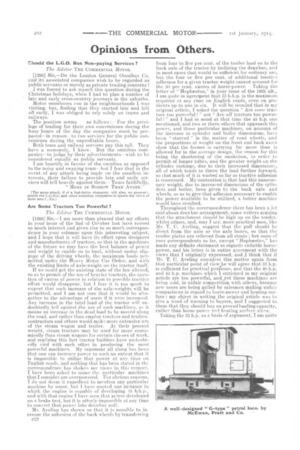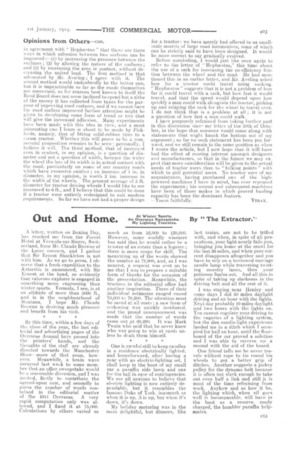Opinions from Others.
Page 14

Page 15

If you've noticed an error in this article please click here to report it so we can fix it.
Should the L.G.O. Run Non-paying Services ?
The Editor THE COMMERCIAL MOTOR.
[1292] Sir,—Do the London General Omnibus Co. and its associated companies wish to be regarded as public servants or merely as private trading concerns 't I was forced to ask myself this question during the Christmas holidays, when I had to plan a number of late and early cross-country journeys in the suburbs.
_Motor omnibuses run in the neighbourhoods 1 was visiting, but, finding that they started late and left off early, I was obliged to rely solely on trams and railways.
The position seems as follows : —For the privilege of trading for their own convenience during the busy hours of the day the companies must be prepared—in reason-to run services for the public convenience during the unprofitable hours.
Both tram and railway services pay this toll. They have a monopoly. I know. But the omnibus companies—to judge by their advertisements—wish to be considered equally as public servants.
I am heartily in favour of the omnibus as opposed to the noisy and swaying tram—but I fear that in the event of any attack being made on the omnibus interests, their failure to provide late and early services will tell heavily against them.—Yours faithfully,
'MORE IN SORROW THAN ANGER.'
[The eame attack, if of a legi;lative character, witi a]so, we presum,, enable the L.G.O.C, and other motorbus companies to ignore the views of their men
Are Some Tractors Too Powerful?
The Editor THE COMMERCIAL MOTOR.
[1293] Sir,—I am more than pleased that my efforts in your issue of the 2nd of October last have roused so much interest and given rise to so much correspondence in your columns upon this interesting subject, and I hope that it will have its effect upon designers and manufacturers of tractors, so that in the machines of the future we may have the best balance of power and weight. to enable us to haul, without undue slippage of the driving wheels, the maximum loads permitted under the Heavy Motor Car Order, and with the existing limits of axle-weight on the tractor itself.
If we could get the existing state of the law altered, so as to permit of the use of heavier tractors, the queStion of excess of power in relation to possible tra.etive effort would disappear, but T fear it is too much to expect. that such increase of the axle-weights will be permitted, and I am not sure that it would be altogether to the advantage of users if it were increased. Any increase in the total load of the tractor will undoubtedly tell against the use of such machines, as. it means an increase in the dead load to be moved along the road, and rather than employ tractors a-nd trailers, contractors and others would make more extensive usfe of the steam wagon and trailer. At their present weight, steam tractors may be used far more economically l'han steam wagons for certain classes of work, and realizing this fact tractor builders have undoubtedly vied with each other in producing the most powerful machines. My argument all along has been that one can increase power to such an extent. that it is impossible to utilize that power at any time on English roads, and nothing that has been stated in the correspondence has shaken my views in this respect. I have been asked to name the particular machines that I consider are overpowered. For obvious reasons, I do not deem it expedient to mention any particular machine by name, but I have quoted one instance in which the engine is capable of developing 15 b.h.p., and with that engine T have seen that. power develoned on a brake test, but it-is utterly impossible at any time to convert that power into drawbar null.
Mn Aveling has shown usthat it is possible to increase the. adhesion of the back wheels by transferring c12 from four to five per cent, of the trailer load on to the back axle of the tractor by inclining the drawbar, and in most cases that would be sufficient for ordinary use, but the four or five per cent. of additional tractive adhesion for a given tractor weight cannot account for the 50 per cent. excess of horse-power. Taking the letter of " Hophnestus," in your issue of the 18th ult.,
am quite in agreement that 33 b.h.p. is the maximum required at any time on English roads, eizen on gradients up to one in six. It will be recalled that in my original article, I asked the question " Are some trac tors too powerful ? " not "Are tractors too powerful ?" and I had in mind at that time the 45 h.p. one mentioned-, and two or three others that approach this power, and those particular machines, on account of the increase in cylinder and boiler dimensions, have been "starved " in the matter of road wheels, and the proportions of weight on the front and back axles show that the former is carrying far more than is allowed for in the average design, the reason for this being the shortening of the smokebox, in order to permit of longer tubes, and the greater weight on the cylinder castings, due to their increased dimensions, all of which tends to throw the load further forward, so that much of it is wasted so far as tractive adhesion is concerned. My contention is that had this unneeessary weight, due to increased dimensions of the cylinders and boiler, been given to. the back axle and wheels, so as to give that adhesion necessary to enable the power available to be utilized, a better machine would have resulted.
Throughourthe correspondence there has been a lot said about drawbar arrangement, some writers arguing that the attachment should be high up on the tender, whilst others, and, may I say, more practical men, like Mr. T. C. Aveling, suggest that the pull should be direct from the axle or the axle boxes, so that the tender plates are relieved from all strain ; but none of your correspondents so far, except "Hephstus," has made any definite statement as regards suitable horsepower, and his letter is in entire agreement with the views that I originally expressed, and,I think that if Mr. T. C. Aveling considers this matter again from that particular point of view he will agree that 33 h.p. is sufficient for practical purposes, and that the 40 h.p. and 45 h.p. machineswhich 1 criticized in my original article are too powerful, and.yet these machines are being sold, in unfair competition with others, because new users are being gulled by salesmen making unfair comparisens in regard to horse-power and heating surface; my object in writing the original article -was to give a word of warning to buyers, and I suggested to. them that they should buy on proved hauling capacity, rather than horse-power arel heating surface alone. Taking the 33 h.p. as a basis of argument, I am quite in agreement with " Hophfestus" that there are three ways in which adhesion between two surfaces can be improved :—(1) by increasing the pressure between the surfaces; (2) by altering the nature of the surfaces ; and (3) by increasing the area in contact, without decreasing the united load. The first method is that advocated by Mr. Aveling ; I, agree with it. The second method would undoubtedly be the better one, but it is impracticable so far as the roads themselves Eye concerned, as for reasons best known to itself the Road Board does not seem inclined to spend but a tithe of the money it has collected from taxes for the purpose of improving road surfaces, and if we cannot have the road surface improved further attention might be given to developing some form of tread or tire that will give the increased adhesion, Many experiments have been made with this idea in view, and a most interesting one I learn is about to be made by Pickfords, namely, that of fitting solid-rubber tires to a. steam tractor. Whether this will prove to be a cornincucial proposition remains to be seen ; personally, I believe it will. The third method, that of increased area in contact, in my opinion, is a question of diameter and not a question of width, because the wider the wheel the less of its width is in actual contact with the road, particularly on some of our country roads which have excessive camber ; an increase. of t in. in diameter, in my opinion, is worth 2 ins, increase in the width of the wheels. The present average of 5 ft. diameter for tractor driving wheels I would like to see increased to 6 ft., and I believe that this could be done if a tractor were entirely redesigned to suit modern requirements. So far we have not had a proper design
for a tractor: we have merely had offered to us smallscale models of large road locomotives, none of which can be strictly said to have been designed. It would be more correct to say gradually evolved. Before concluding, I would just like once again to refer to the letter of " gephEestus," this time about the use of a sack for increasing the co-eciency friction between the wheel and the road. Ile had mentioned this in an earlier letter, and Mr. Aveling asked how far a tractor could travel using sacking. " Hephtestus " suggests that it is not a problem of how far it could travel with a sack, but how fast it would travel, and that the speed would depend upon how quickly a man could walk alongside the tractor, picking up and relaying the sack for the wheel to travel over. I do not think that is a problem at all ; it is not a question of how fast a man could. walk.
I have purposely refrained from taking further part in this discussion since my letter of the 30th of October, in the hope that someone would come along with statements that, might knock the bottom out of my argument ; so far no such statement. has been put forward, and we still remain in the same position as when wrote the article, but I now hope that it will have had the effect of rousing interest amongst designers and manufacturera, so that in the future we may expect that more consideration will be given to the actual needs of tractor users than to "talking points " with which to gull potential users. No tractor user of my acquaintance, having purchased one of the highpowered machines I have in mind, has ever repeated the experiment ; his second and subsequent machines have been of those makes in which proved hauling capacity has been the dominant feature.
—Yours faithfully, VERax.




















